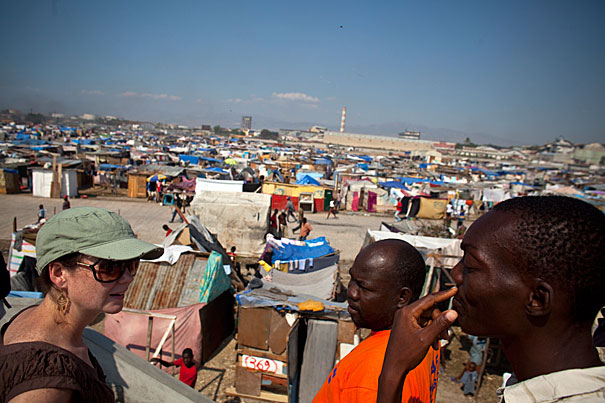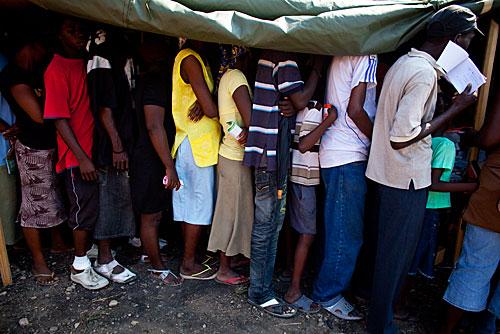
Harvard faculty members working to improve Haitians’ lot expressed impatience with the pace of recovery this week even as they pointed to milestones that show slow progress being made — such as groundbreaking for a major teaching hospital.
File photos by Justin Ide/Harvard Staff Photographer
Progress in Haiti ‘painfully slow’
A year later, Harvard faculty members see small signs of hope but a long road ahead
A year after Haiti’s deadly earthquake, nearly a million people still live in temporary tent cities, plagued by sexual violence and hopelessness. In downtown Port-au-Prince, large sections of the city remain rubble-strewn, as if the quake happened days, not months, ago.
Harvard faculty members working to improve Haitians’ lot expressed impatience with the pace of recovery this week even as they pointed to milestones that show slow progress being made — such as groundbreaking for a major teaching hospital.
“The progress has been really slow; it’s been painfully slow,” said Instructor in Medicine David Walton, a physician with Harvard-affiliated Brigham and Women’s Hospital and the nonprofit Partners In Health (PIH), which has worked to improve health care in Haiti for decades. “If you drive through Port-au-Prince, it looks like the earthquake happened last week, not 12 months ago.”
Associate Professor of Medicine Joia Mukherjee, another Brigham physician who serves as Partners In Health’s chief medical officer, said in a recent PIH conference call that the organization was “proud of the work we’ve done, yet we’re humbled by the need that remains.”
Mukherjee, who was joined on the conference call by PIH President and Executive Director Ophelia Dahl and PIH Chief Program Officer Ted Constan, said the initial quake response by nongovernmental organizations, international donors, and foreign governments was “heroic,” but added that in the months since, the response has become fragmented and uncoordinated. A major concern is the million-plus people still in temporary camps, but Walton said he doesn’t see those sites closing any time soon.

Constan said that sexual violence in the camps is at “horrific” levels and that political infighting is hampering the search for new places for people to live.
“Clearly for us the biggest problem out there is the million displaced people and their living conditions,” Constan said. “We begin to join the chorus of impatience being expressed toward the response.”
Rehabbing amputees is another ongoing issue. Mukherjee said recent estimates of between 4,000 and 5,000 amputees in the country seem too low, since Partners In Health alone did several thousand surgeries during the weeks after the earthquake. If it’s accurate, the number may reflect the poor state of health care in Haiti and mean that there were many deaths from infection in the weeks and months after surgery, Mukherjee said. For those who survived, Mukherjee said, physical therapy remains a significant need, as the nation has very few physical therapists.
On the positive side, Walton has been a guiding force behind the construction of a major new hospital in the town of Mirebalais. Though the hospital had been planned before the earthquake, the Haitian government asked Partners In Health to redesign the facility in the disaster’s wake, speeding up construction, making it larger, and making it a national teaching hospital, Walton said.
“We literally redesigned the hospital almost completely,” Walton said. “It went from a small, regional facility to a large, national teaching hospital.”
Hospital care in Haiti has been centered around Port-au-Prince’s General Hospital, which was badly damaged in the quake. Walton said the new facility, which will have 320 beds, six operating rooms, and 220,000 square feet of space, is intended to complement the General Hospital, not replace it.
As some Harvard-affiliated faculty members work on the new permanent hospital, others reflect on a temporary one, which has given way to a Haitian-run clinic.

Michael VanRooyen, director of the Harvard Humanitarian Initiative (HHI) and associate professor of medicine and of public health, said the organization’s temporary field hospital set up at Fond Parisien in the days after the quake treated 2,000 patients before closing in May. The hospital, which operated on the compound of the Love A Child Orphanage and focused on rehabilitation and follow-up care, was one of the main receiving points for patients from the U.S. Navy’s hospital ship, USNS Comfort, anchored in Port-au-Prince’s harbor.
As the hospital closed, HHI-led personnel opened a medical clinic to continue to serve rehabbing patients and medical needs at the nearby 1,700-person displaced persons camp, Camp Hope, run by the American Refugee Committee.
After several months of HHI leadership, the facility, called Klinik Lespwa, “clinic of hope,” transitioned to Haitian staff in November, when HHI ended its involvement there.
“It was always designed to be a temporary hospital,” VanRooyen said of the field hospital. “Our goal has always been to ramp it down and get people to [permanent Haitian-run facilities].”
VanRooyen said HHI’s hands-on involvement in post-earthquake work was an expansion of the organization’s traditional role of research, training, and academic engagement. Now, he said, HHI is returning to a research-based role, offering insights that aim to improve the work of front-line organizations rather than providing services itself.
As the crisis developed, HHI called on its network of people who had worked with HHI and participated in HHI training exercises over the years. Many of them answered the call, dropping what they were doing to fly to Haiti, staff the field hospital, and put their training into action.
“The team performed beautifully,” VanRooyen said. “I was proud to see the translation from training to real life, which is what HHI is all about.”





